Chapter 10
Your Skills
In This Chapter
• Data, things, and people skills in the world of work
• Choose the skills you want to use in your career
• Skills that are transferable to other jobs and careers
• Identify your self-management skills
• Think about your natural abilities or talents
There are many sides to looking at your skills. Some of your skills seem like natural abilities or talents. These skills have been honed and developed over time and come easily to you. You also have self-management skills. Each of us has a different set of self-management skills that indicate how our attributes can contribute to getting results on the job as well as getting along with others. Then there are skills we use to work with data, things, and people. Most of us have a preference for one of the three. And most occupations are made up of one or more of these skill sets. Still other skills you have are ones that can transfer to other careers and occupations. Isn’t that good news! This chapter will explore all these different aspects of your skills.
Three Types of Skills
Imagine that directly in front of you are three boxes, each of which contain a path to your future. You are supposed to choose one. One of these boxes is the right box for you and will bring you all the happiness in the world. The other boxes are filled with boredom and a life of discontent.
The first box represents using skills of the heart where you work with people most of the time. The second box is full of skills that keep your mind active as you work with data and ideas. The third box is filled to the brim with skills that use your physical ability to work with all kinds of things. Each box is beautifully wrapped and has colors and patterns that appeal to you. You are drawn to aspects of each, so how do you decide which one holds true happiness?
The boxes represent three categories of skills that are found in the world of work. All occupations are made up of some combination of the three basic skills. And, most occupations have one of these skills areas as their main requirement. The three basic types of skills are:
• People skills (box number one)
• Data skills (box number two)
• Things skills (box number three)
People Skills
All of us are involved in using people skills in our work place. These are the skills we use to influence others and to be of help to others. Leaders and salespeople are primary examples of occupations that directly relate to influencing skills. On the other hand, counselors, human resource personnel, teachers, and customer service people use primarily helping skills.
Data Skills
There are three ways of approaching working with data. One is through analyzing data. People who enjoy using their minds to figure out how to use data, how to organize it, and how to make it useful use analyzing skills. Accountants, air traffic controllers, and office assistants use analyzing skills.

nsider Tips
There are two sides to people skills. On one side is showing consideration for others. Being a good listener and understanding others’ points of view are critical to your success. It doesn’t matter what your job is or what your position is in the organization, you need to be able to get along with others. Getting along doesn’t mean going along. The other side of people skills is being confident in expressing your own thoughts, ideas, and opinions clearly. Being a contributor is also critical to your success.
A second area of data skills is in the realm of ideas. Here you are often working with data to present it to others in the form of ideas. Speech writers and advertisers put data together to articulate ideas that their audience will be able to comprehend.
The third way to look at data skills is through a creative approach to the data. If you prefer to work with data to create something from scratch, then you fall in the “creative” skills area. Artists and people who invent or create new things out of data are found in the creative category of data.
Things Skills
Things skills are found in a couple of areas. People who like to work with concrete things such as materials, metals, tools, and plants are in the area of producing skills. You are using materials to produce an end product—a garden, a house, a bridge.
The second area is focused on using physical ability as the basis of your skill. Athletes, fitness trainers, and military personnel fall into the category of adventure skills.
One Box or Many?
Many people find that the skills they love to use or learn are primarily in one of the three boxes of skills. Brad is a good example of this. He is a sculptor, and he loves working with metal to create art. His total focus is on creating his work. His skill preferences are definitely in the things skills area. So for Brad, choosing the things box would bring him the most happiness. Often people in the arts need others to promote and sell their work because this is not where their skills lie. They need people with people skills!
How about the rest of us who don’t find ourselves so neatly in one box? And that would be most of us! How about Jean who loves to work with people? She is a leadership consultant and takes great pride in helping people in positions of leadership to develop. So although she is solidly in the people skills area, she also loves to create watercolor paintings. These skills fall within the data skills box because she has to pay more attention to her use of materials, visualizing shapes and colors and working with the details involved in creating a work of art. She also incorporates her art in her work as a consultant, designing concrete models of growth and change that are artistically presented to her clients. So we can find ourselves combining the skills we really love into one career or occupational area.
The next section will help you to begin to think about your skills in each of the three work activity skill categories of data, things, and people. You may begin to see a relationship between your interests that you identified in Chapter 9 and the skills you like to use here.
Skills Inventory Assessment
Consider each skill listed under the three work skills categories: data, things, and people. Now perform the following steps:
1. Put a check mark in the “I Have This Skill” column if you have some expertise in using the skill.
2. Put a check mark in the “I Want to Use This Skill in My Work” column if you really love this skill and want to find an occupation where you can use this skill.
3. Put a check mark in the “I Need to Get or Develop This Skill” column if you want to learn this skill or improve your expertise in using this skill. Remember today’s organizations require that you keep your skills up to date and be willing to learn new skills as the skill requirements for your job change.
4. Use the blank spaces (Other) at the end of each work skill list to write any skills you have that were not listed. This list is meant to stimulate your ability to identify your own skills in each of the work skills categories.
Skills Inventory
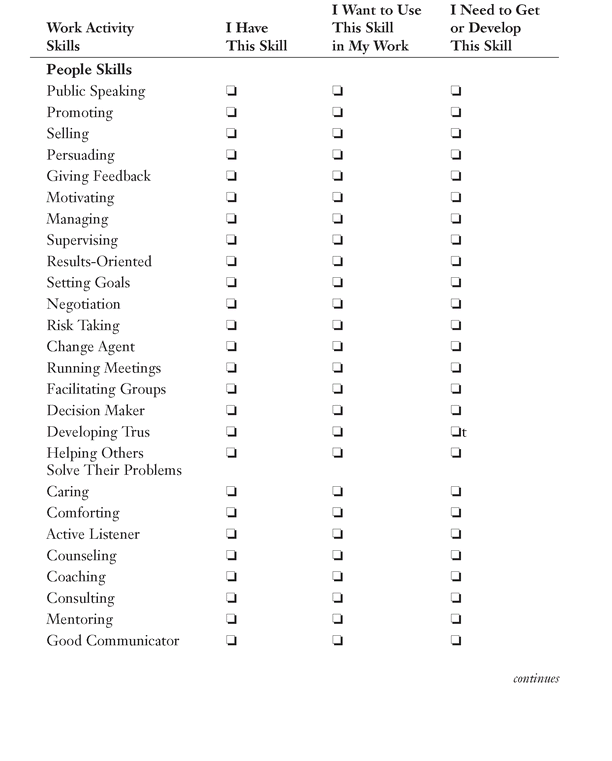
Skills Inventory (continued)


Skills Inventory (continued)
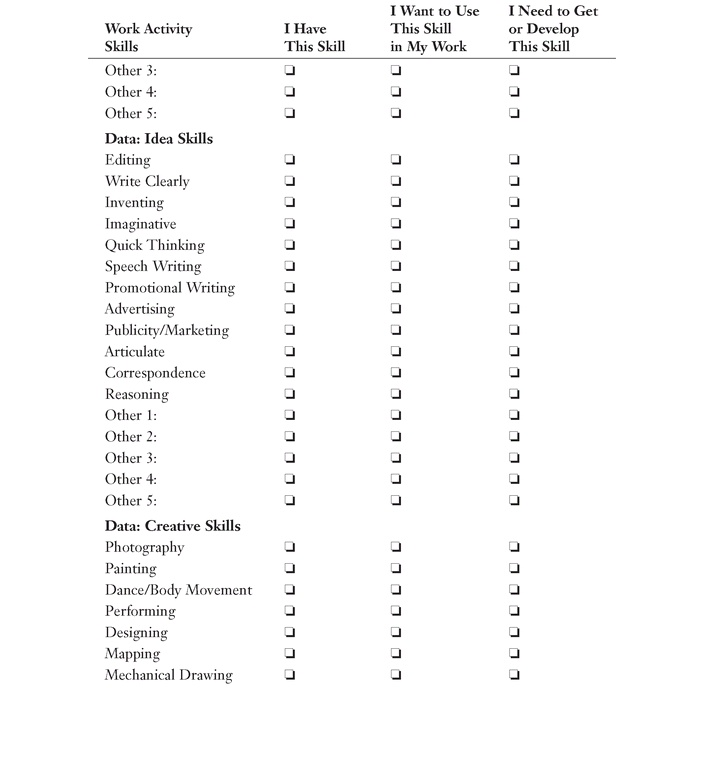
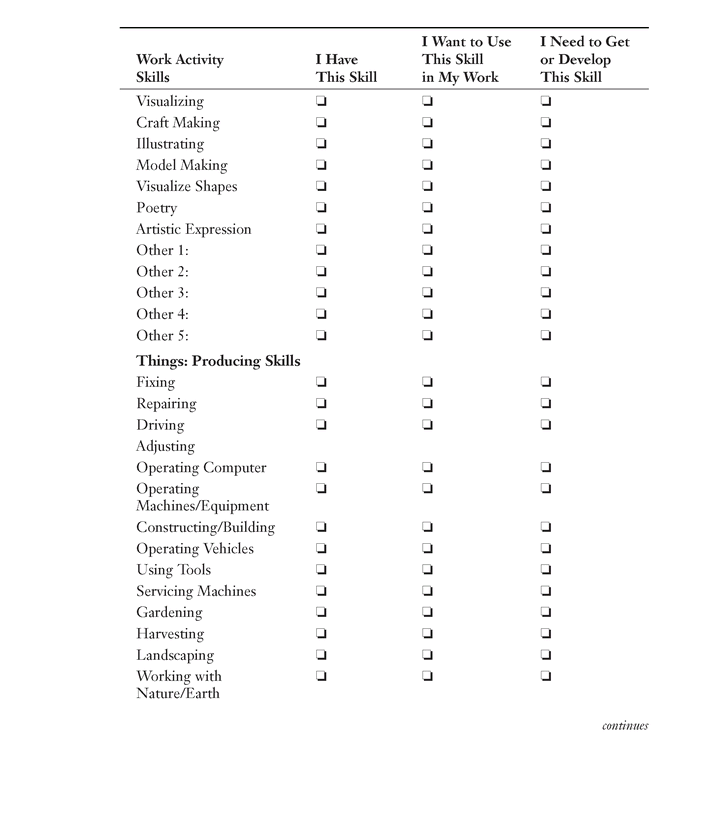
Skills Inventory (continued)
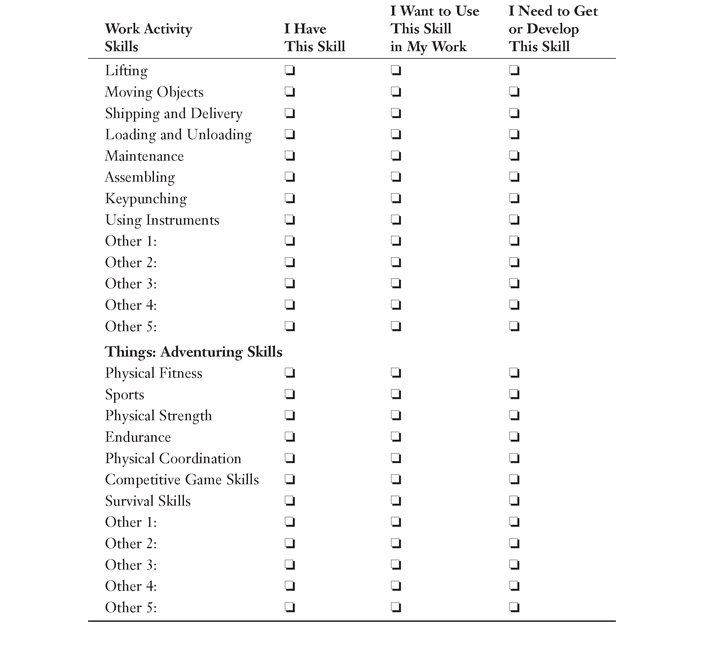
Why make a distinction between skills you have and skills you really want to use? Wouldn’t you want to let an employer know all your skills? Well consider this example. Raul is great with numbers. His parents think he should be an accountant. He is happy to have this ability, but he doesn’t see it as a driving force in his work. Raul loves sports—loves to persuade and influence people and sees himself right in the middle of the action. Maybe he’ll be a recruiter or go into sports management. It’s great to have many skills. And it’s even greater to put the ones out front that we really love to use.
Rank Your Skills
Identifying the skills you want to use in your occupation helps you in several ways. You can be clear with everyone you speak to that these are the skills you want to use—no chance here of finding yourself in the wrong job! You can also use this combination of skills to locate occupations that use these skills—more on this in Chapter 17. Above all, this list will keep you focused on finding an occupation and a career that is going to allow you to use skills you love.
In the chart that follows, list the Data, Things, and People skills you checked off in the last two columns. Once you have listed the skills you want to use and develop, take a few minutes to rank order these skills, starting with the one you love the most. This rank order takes into consideration all the skills you listed in all three sections of Data, Things, and People. Think about the skills you really must be able to use in your perfect career. We realize this is tough to do, but it forces you to acknowledge to yourself the skills that will make you the happiest if you can use them every day on your job.
Now go to your Career Profile Map in Appendix A and record your skills chart in the Skills section. When we get to Chapter 17, look at the occupations that match the skills you have listed in this section of your Career Profile Map.

Skills Chart
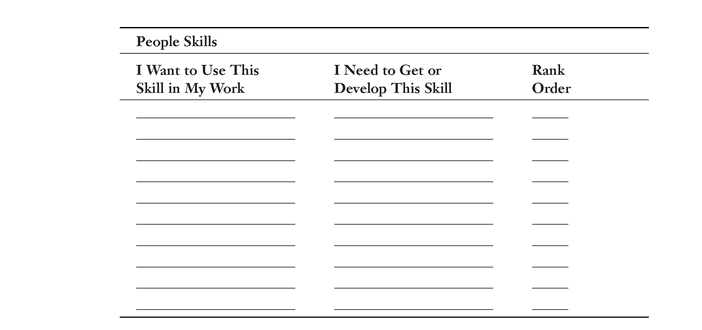
Skills to Go
We start to develop skills as soon as we arrive on Earth. And we continue to develop them through all kinds of life experiences—education, work, leisure activities and interests, and stepping up to challenges. It’s important to understand the different ways in which we can identify and apply our skills. There are four unique ways we can look at our skills. Each of these is defined here:
• Skills you want to use on the job. The Skills Chart you just completed identifies the skills you want to use on your job.
• Skills that are “transferable.” These skills that can move with you from job-to-job and don’t have to be associated with only one occupation.
• “Self-Management” skills that employers look at very carefully. These are skills that set the tone for how you approach your work tasks and the people at work.
• Skills that you are naturally talented at using. These are skills that you have had from a very early age that you continue to perfect over time. They are generally skills that come easily and you have developed to an expert level.
These last three skill areas are great because you already have them! So wherever you go, they are packed and ready to go with you. The sections that follow will describe them in more detail.
Coach Wisdom
Do not, I repeat, do not underestimate your skills. Take the time to really look at skills you have been using in your life, work, home environment, community work, or volunteer work. Many times when people have been out of the workforce for a while, they think all their skills have atrophied. Guess what? You’re using skills no matter what you are doing in life. So take out your microscope and really look at the skills you use in your everyday life.
Transferable Skills Assessment
Transferable skills are general skills that can be used in many different settings and activities. You can transfer these skills from one occupation to another and from one organization to another. Examples are communicating, supervising, analyzing, physical coordination, and operating. In fact, many of your work activity skills are transferable skills! Let’s look at supervising as an example of a transferable skill.
You have been a supervisor in a high-tech company where you supervised five project managers. You decided to change fields and move into an educational testing firm where you will be expected to supervise three departments. You will have to learn another corporate language and some different organization culture behaviors. However, your knowledge about how to supervise people is a transferable skill that you can adapt to this new position. It makes you more attractive to a new employer because they don’t have to train you in how to supervise. They also value having a person with experience in this skill area.
Identifying your transferable skills can help you to more easily move into new territory with confidence based on your experience.
Designing, supervising or managing people, instructing others, public speaking, sales, solving problems, project planning, running meetings, budgeting, and using computers are transferable skills. This list is meant to stimulate your thoughts about your own skills, so don’t be limited by them. If you need to, go back to the Skills Inventory table in this chapter where you checked off the skills you have and want to use in your work.
Now, make a list of what you consider to be your top five transferable skills. These are key transferable skills that you see as strengths for you and ones you want to be able to use in your work.
Top Five Transferable Skills 

Record these skills in your Career Profile Map in Appendix A. Remember, you always want to put your best foot forward. In order to do this, you must know your strengths and which ones you really enjoy using.
Self-Management Skills
Self-management skills are our strengths in working with people and managing resources. Examples of these are being punctual, dependable, imaginative, and efficient.
Employers look to these skills to judge a candidate’s character and ability to manage his own performance on any job. Employers want to know whether or not you can make a positive contribution to the work environment. They look for people who can provide the most value in terms of occupational skills and personal qualities.

Career Lingo
Self-management skills are personal qualities you use in your work. Your sense of humor, your tenacity, or your sense of responsibility can set you apart from others applying for a position. In addition, self-management skills are about assets you use to get along with others. These can be tone setters that contribute to a work environment such as being friendly and honest in your communication.
Take a look at the list of self-management skills on the Self-Management Grid that follows. Circle the skills that demonstrate the personal qualities you bring to your work. At the bottom of the grid, add any skills you have that are not already listed.

List the top five self-management skills that represent you the best.
Top Five Self-Management Skills 

Record these skills in your Career Profile Map in Appendix A.
Assess Your Talents
You have already assessed yourself on all the skill fronts, so now I want you to look at all the skills you have recorded in the skills section of your Career Profile Map in Appendix A. As you go down your list, highlight those skills you consider to be your special talents. Consider those skills that you can remember using from a very early age or that are easy and natural for you to do. Think about the ones that other people count on you to do. Talents can be in any category of working with data, people or things, self-management, or transferable skills. You may be really good at problem solving, or project management, or scientific experiments, or solving math problems, or helping people with their problems.
Many employers these days are looking for people who can identify their talents and use them easily in the workplace. Why? They can save a great deal of time and money spent in training people to do what some people are already very good at doing. It gives you an advantage when you can articulate what your talents are and how you have used them.
Once you have highlighted your talents, list them in your Career Profile Map in Appendix A.
Using Your Results
It’s important to remember that you get to choose the skills you really want to use. The only way you get there—besides stumbling into a great career—is to identify what you want and plan to get it. You are on your way!
The Least You Need to Know
• There are three categories of skills in the world of work: working with data, working with things, and working with people.
• Identifying the skills you really like to use will help you to find occupations where you can use them.
• Everyone has skills that are transferable from one job to another or even to new career areas. Identifying these transferable skills makes it easier to transition into new areas.
• Employers want people with good self-management skills. These are skills that you use to work well with others as well as personal qualities that set you apart from others.
..................Content has been hidden....................
You can't read the all page of ebook, please click here login for view all page.
